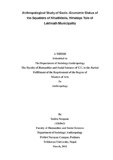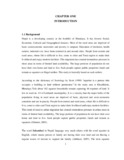Please use this identifier to cite or link to this item:
https://elibrary.tucl.edu.np/handle/123456789/241| Title: | Anthropological Study of Socio -Economic Status of The Squatters of Khudikhola, Himalaya Tole of Lekhnath Municipality |
| Authors: | Neupane, Indira |
| Keywords: | Anthropological Study;Socio -Economic Status |
| Issue Date: | Mar-2012 |
| Publisher: | Central Department of Sociology |
| Level: | Masters |
| Abstract: | The general objective of this study is to explore out the socio-economic status of squatters of Khudikhola, Himalaya Tole, settlement of Lekhnath Municipality by using anthropological lenses. Through a scrutiny of socio-economic status of 182 households of squatter’s settlement of Khudikhola, this study explored and derived solution and challenges related to socio-economic status and the consequent consequences and implications. Squatter are illegal settlers and have no lands of their own or any other properties with their ownership. Poor people gathering from different places, different castes and ethnicity forming a settlement is known as squatter’s settlement. The squatter settlement of Khudikhola is an unplanned settlement, having simple houses and low Socio-economic status of the people. People migrated to Khudikhola for seeking jobs or work, as they did not get the opportunity to work in their previous villages. Some people came here because of landslide and flooding in their previous habitat. Some people had other causes e.g. easy access to roads, city life and good education in city area, which acted as a pull, factor for their migration to this region. This study deduced that the main causes of becoming squatter and leading the life of a squatter were pull factors (job opportunity, education facility and transportation, communication etc. of the city area) and push factors (landslide and flooding, poverty, etc.) of their place of origin. Social indicators encompassing a wide range of aspects are crucial for generating their consequences on development. Measures to indicate social progress, “social indicators,” have been conversed in this study, and the importance of economic indicators considered undeniable. Empirical measures of cultural states in comparison also remain vital. This study traced how an integrated framework combining social and cultural indicators of development may be applied to measure social status of the squatters of Khudikhola. Embedded with social status, the religious practice of the settlement is simple. More people used to celebrate their festivals in simple forms. They celebrate their festivals from religious perspective. It has been comprehended that there are different religions and different castes people in the study area. However, they are helpful to each other and there have been not much conflicts but other economy based conflict has been seen here. There has been a rise to culture of poverty—influencing all aspects of squatters’ life. In the context of health, squatter visit health service centers for health check up when they get sick. Some people go to regional hospital, some go to private clinic, and some others go to pharmacy and purchase medicines from the medicine seller without a physician’s prescription and this tendency is dangerous as it can create dangerous health consequences in future. The patient may die of wrong or date expired medicines. Family planning has also been practiced in the Khudikhola squatter’s area among the married couples. It has been deduced that permanent family planning was adopted more than the temporary measures of family planning. Women have been found to participate actively, more than male in family planning practices. This shows the rising consciousness of women despite the prevailing socio-economic and education related disparities in study area. In Khudikhola adult illiteracy rate is high because absence of adult literacy program in that area. However the school attendance of new generation is higher than old generation and this shows the progressive attitude of the squatters and their optimism for a better future lying ahead of them. This study has construed that women are partners for sustainable participation. Thus, they have prominent role to play in development along with males but it is not so in authenticity as different sorts of gender inequalities curtail their roles in the society. Many women are involved in wage earning labor work along with males but they are to do household works also thus they face the dichotomy of dual role – household chore vs. wage earning labor works. Women also face discriminations in wages even for same work. The plight of female and gender equalities have underwent through tough tribulations related to social, cultural and economic matters. Regarding the economic status, the maximum numbers of squatters are engaged in daily wages works and many people are engaged in Labor work. Few people are pursuing businesses in the study area. Many people depend on labor work in Khudikhola settlement. The main source of household income is labor wages whose percentage is 74. The income sources of households are more than one occupation in some houses but many houses have only one source of income—that is wage labor. Comparatively squatter’s income is lower than other people’s but within the settlement, those squatters’ households which have more than one people engaged in some earnings, have definitely better income than others do. Nowadays, many people have gone to foreign countries, as a result some household’s income is raising due to their remittance but in general, average income in squatters is low in Khudikhola settlement. Poverty is rampant to such an extent that not all squatters could buy their wearing cloths. Some squatters buy themselves; some used to get from their relatives, whereas some received cloths from others. All the households do have toilet facilities available in that settlement. Housing opportunities are very closely related to economic status of a family. Better housing means sound economic status. In Khudikhola, significant numbers of households have two rooms available in their houses. It is understandable that many people live in small houses in squatter settlements and this presents the worst economic conditions of the squatters in Khudikhola. Embedded to economic status, the availability of commodities, amenities of life and entertainment is vital. In Khudikhola more families watch TV for entertainment. In total, 36 % households have VCD/DVD and 5% people have Radio. Therefore, the people in squatter settlement have a comparatively improving access to the means of entertainment despite their dreary economic conditions. This shows the jolly and warm-hearted nature of the squatters despite problems. Of the total 182 households, the landline phone is not available in any household; however, 82% people had cell phone (mobile phone) which shows the increasing vitality of the means of communication. Most of the households have used electricity in their houses and 49% households used gas stove for cooking which shows a comparatively higher standard of living. However, few people possessed cupboard and sofa. Squatter people had different tribulations, which they are facing in present. They are addicted to different types of infatuation. As a whole, squatter people were used to drink alcohol more commonly. Among 182 household respondents, only 45 people did not have any types of addiction. Therefore, addiction as alcoholism, smoking, using tobacco are the major problems of squatters, which is at appalling rate deteriorating their socio-economic status. It is summarized at the end that the squatter of Khudikhola as illegal settlers face social and economic problems in the settlement; even the problem of proletariatisation may be the possible consequences in future. Since squatters came there from different places having different cultures, they have some sort of difficulties to interact with each other initially and there may be the lack of class-consciousness, class solidarity and the polarization of these squatters for more rights. Thus, their problems remain intact. |
| URI: | http://elibrary.tucl.edu.np:8080/jspui/handle/123456789/241 |
| Appears in Collections: | Anthropology |
Files in This Item:
| File | Description | Size | Format | |
|---|---|---|---|---|
| cover.pdf | 890.58 kB | Adobe PDF |  View/Open | |
| Chapter.pdf | 2.41 MB | Adobe PDF |  View/Open |
Items in DSpace are protected by copyright, with all rights reserved, unless otherwise indicated.
